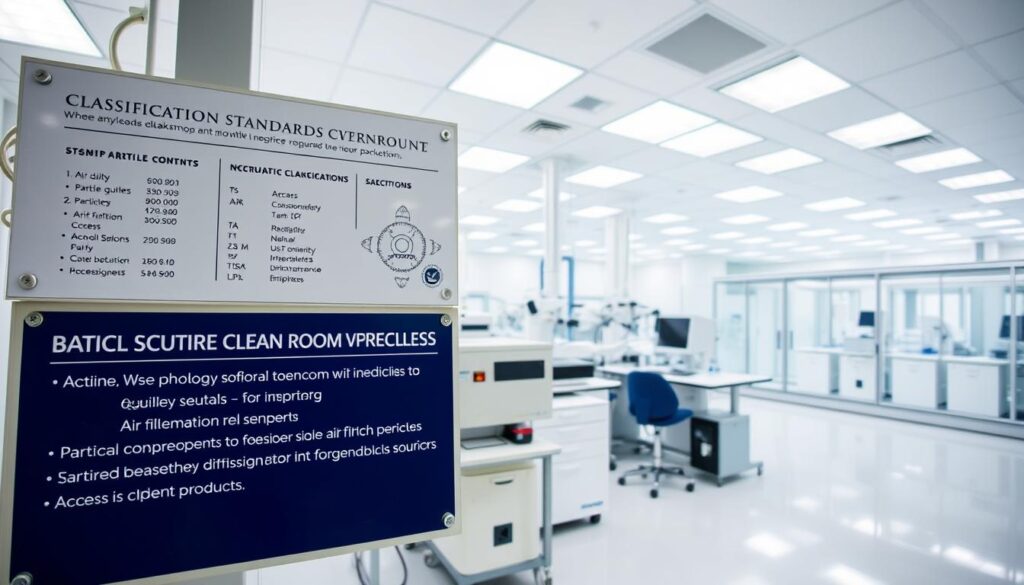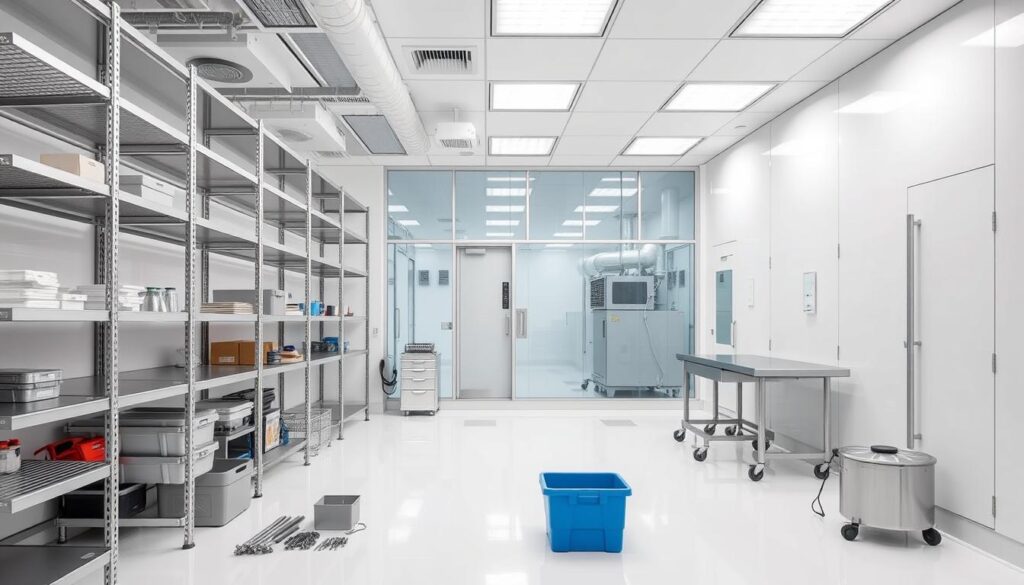What if the air you’re breathing right now could ruin a billion-dollar manufacturing process? This isn’t science fiction—it’s the daily reality for industries relying on controlled environments. From life-saving pharmaceuticals to cutting-edge semiconductors, even microscopic particles can derail production. How do these specialized spaces stay flawlessly functional?
Cleanrooms are engineered to minimize contamination through advanced air filtration and strict protocols. They’re not just “sterile rooms”—they’re precision systems maintaining specific temperature, humidity, and pressure levels. Industries like aerospace and biotechnology depend on these spaces to meet rigorous quality standards.
You might wonder why standards vary so widely. A medical device facility has different needs than a semiconductor manufacturing plant. The answer lies in particle size tolerance and process sensitivity. We’ll explore how ISO classifications dictate everything from airflow patterns to worker gowning procedures.
Key Takeaways
- Cleanrooms prevent contamination in industries like healthcare, tech, and aerospace
- Air filtration systems remove particles down to 0.1 microns
- ISO standards define requirements based on operational needs
- Environmental controls include temperature, humidity, and pressure
- Proper gowning protocols protect both workers and products
Introduction to Clean Room Essentials
Behind every microchip and vaccine lies an invisible battlefield against microscopic invaders. These specialized spaces combine science and precision to protect sensitive processes from invisible threats. Cleanroom essentials aren’t about basic tidiness—they’re about creating a fortress against particles measured in microns.
The ISO 14644-1 standard defines these areas as “controlled environments where airborne particles are managed through design and strict protocols.” This means every detail matters—from filtered air replacing the entire volume every few seconds to surfaces that resist shedding microscopic debris.
Three pillars keep these spaces functional:
- Advanced filtration capturing 99.97% of particles down to 0.3 microns
- Non-porous materials preventing microbial growth
- Gowning procedures stricter than surgical protocols
Contamination risks lurk everywhere—human skin cells, machine lubricants, or airflow turbulence. That’s why clean room designs use positive air pressure to push out unwanted elements. Temperature and humidity stay locked within narrow ranges, preventing static or condensation that could disrupt delicate work.
From pharmaceuticals to nanotechnology, these environments enable breakthroughs by controlling variables most people never notice. As one engineer puts it: “We’re not just cleaning the air—we’re engineering emptiness.”
Defining the Clean Room: Classification and Standards

Ever wondered why some controlled environments feel like sterile hospitals while others resemble tech labs? The answer lies in cleanroom classification systems – the universal language for contamination control. These frameworks ensure precision across industries, from semiconductor plants to vaccine production lines.
How Clean Room Classifications Work
Classification starts with counting invisible particles. Imagine comparing dust specs to sugar grains – that’s the scale we’re measuring. Two main systems dominate:
- Federal Standard 209E: Uses simple math – class 100 means ≤100 particles (0.5µm+) per cubic foot
- ISO 14644-1: Employs logarithms for tighter control, tracking smaller 0.1µm particles per cubic meter
These cleanroom standards dictate everything from air changes per hour to worker protocols. A class 100 space (ISO 5) might house delicate circuit boards, while class 100,000 (ISO 8) could handle appliance component assembly.
Comparing FS 209E and ISO 14644-1
Here’s why both systems matter:
| Feature | FS 209E | ISO 14644-1 |
|---|---|---|
| Measurement Unit | Cubic foot | Cubic meter |
| Particle Size | 0.5µm | 0.1µm |
| Common Classes | 1 to 100,000 | ISO 1 to ISO 9 |
While FS 209E remains popular in US aerospace, ISO 14644-1 dominates global pharma. Both ensure spaces meet exact class requirements – because when manufacturing microchips or medicines, one stray particle can cost millions.
Cleanroom Air Flow and Contamination Control
Airflow in controlled environments works like an invisible shield, pushing contaminants away from critical zones. The right combination of filtration and movement patterns determines whether microscopic threats get eliminated or linger dangerously.
HEPA and ULPA Filter Systems
HEPA filters act as microscopic bouncers, blocking 99.97% of particles larger than 0.3 microns. For ultra-sensitive applications like nanotechnology, ULPA filters upgrade this performance to 99.999% efficiency at 0.12 microns. These systems work together with precise air handling units to refresh the entire space’s atmosphere every few seconds.
Laminar vs. Turbulent Air Flow Principles
Two airflow strategies dominate contamination control:
| Type | Pattern | Best For |
|---|---|---|
| Laminar | Unidirectional “river” flow | Pharmaceuticals, microelectronics |
| Turbulent | Mixed air currents | Appliance manufacturing, packaging |
Laminar systems create predictable particle paths, while turbulent designs use strategic chaos to dilute contaminants. Most facilities combine both approaches based on zone-specific needs. As one HVAC specialist notes: “It’s not about eliminating every particle—it’s about controlling where they go.”
Designing a Clean Room: Materials and Construction

Building a contamination-free space starts with its bones. Every material choice impacts particle control and airflow efficiency. Unlike standard construction, these environments demand surfaces that actively fight contamination rather than just resisting it.
Contamination-Free Building Materials
Walls and floors use non-porous polymers or stainless steel to prevent microbial growth. These surfaces eliminate cracks where particles hide, while chemical-resistant coatings withstand daily sterilization. Even adhesives get tested for outgassing—no detail escapes scrutiny.
Ceiling systems act as air traffic controllers. Filter-fan units create downward laminar flows, with low wall returns preventing air turbulence. As one architect notes: “If your ceiling design traps contaminants, you’ve already failed ISO certification.”
Modular construction shines here. Prefabricated panels built in dust-free factories reduce on-site assembly risks. This approach lets facilities scale while maintaining integrity—critical for specialized construction teams working on sensitive upgrades.
Layouts prioritize movement logic. Entry airlocks align with gowning stations, while curved corners guide workers away from critical zones. Every hinge, light fixture, and vent gets recessed to avoid disrupting airflow patterns.
Applications of Clean Rooms in Various Industries
Did you know the smartphone in your pocket required an ultra-sterile environment during production? Controlled spaces enable innovation across sectors most people never consider. From life-saving vaccines to Mars rovers, these specialized areas make modern miracles possible.
Medical Devices, Pharmaceuticals, and Biotechnology
Sterile environments protect patients at every step. Vaccine production demands ISO 5 spaces—that’s fewer than 3,520 particles per cubic meter. Surgical tools get assembled under laminar airflow to prevent infections. Biotech firms use these zones to grow cell therapies that treat cancer.
Medical device manufacturing requires precision beyond hospital standards. Implants like pacemakers undergo final checks in controlled environments to ensure zero microbial contamination. Even packaging happens under HEPA filtration to maintain sterility until use.
Electronics, Aerospace, and Research Initiatives
Your phone’s microchip would fail without particle-free assembly. Semiconductor plants remove 99.999% of airborne contaminants—equivalent to filtering a football stadium’s air through a coffee cup. One dust speck can ruin entire batches of processors.
Aerospace teams assemble satellite components in ISO 7 spaces. These systems must survive cosmic radiation and extreme temperatures. Research labs pushing sustainable manufacturing practices rely on these zones to develop next-gen solar cells and battery tech.
Even snack companies use modified cleanroom concepts. Potato chip bags get filled in low-particle rooms to prevent staleness. As industries evolve, so do their contamination control needs—proving sterile spaces aren’t just for labs anymore.
Modular Cleanroom Systems: Flexibility for a Controlled Environment
What if your lab could grow as fast as your research breakthroughs? Modular systems transform contamination control with plug-and-play precision. These prefabricated units arrive ready to assemble, cutting construction timelines by 70% compared to traditional builds.
Customizable and Scalable Solutions
Need ISO 5 for nanotech today but ISO 7 tomorrow? Modular walls reconfigure like high-tech LEGO® blocks. Panels with baked-on finishes resist chemical spills, while smart integration ports accommodate future sensor upgrades. One aerospace supplier doubled their workspace in 48 hours without halting production.
Factory-built components ensure consistency. Each piece undergoes particle testing before shipping—a quality check traditional sites can’t match. This approach shines for projects requiring environmental adaptability, from humidity-sensitive biolabs to vibration-controlled optics rooms.
Cost-Effectiveness and Quick Installation
Modular isn’t just faster—it’s smarter financially. Tax codes often classify these systems as equipment, yielding 30%+ savings through accelerated depreciation. See how they stack up:
| Factor | Modular | Traditional |
|---|---|---|
| Installation Time | 2-6 weeks | 6-18 months |
| Relocation Cost | 15% of initial | 80% rebuild |
| Energy Efficiency | 25% better | Standard |
Healthcare startups love modular’s phased approach. Begin with 500 sq ft for drug trials, then expand as FDA approvals roll in. As one facility manager notes: “We outgrew three layouts before our first patent issued—modular kept us agile.”
Maintaining a Spotless Clean Room with Best Practices
The most advanced filtration systems can’t compensate for one overlooked detail: human error. Workers account for 70-80% of contamination risks in controlled environments. That’s why rigorous training programs teach staff to become contamination control experts—not just equipment operators.
Effective Cleaning and Monitoring Strategies
Daily protocols start before entry. Specialized gowning procedures transform everyday clothing into particle barriers. Air showers blast away 90% of surface contaminants in 20 seconds, while adhesive floor mats trap lingering debris.
Real-time sensors track particle counts down to 0.1 microns—smaller than most bacteria. These systems alert teams when numbers exceed thresholds, allowing immediate corrective action. Weekly audits verify cleaning effectiveness through surface swab tests and air sampling.
Three elements sustain cleanliness standards:
- Rotating HEPA filter replacements based on airflow metrics
- Color-coded cleaning tools to prevent cross-contamination
- Mandatory re-certification training every six months
By combining technology with disciplined workflows, facilities maintain precision environments where even a single speck of dust becomes statistically improbable. As one quality manager notes: “Our best tool isn’t the air filter—it’s the team’s contamination awareness.”
FAQ
What determines a controlled environment’s classification?
Classifications depend on the maximum allowable particles per cubic meter. Standards like ISO 14644-1 use particle counts at specific sizes (e.g., 0.1 to 5 microns) to define levels from ISO 1 (strictest) to ISO 9. Older FS 209E standards, still referenced in industries like aerospace, measure particles per cubic foot.
How do HEPA and ULPA filters differ in performance?
HEPA filters capture 99.97% of particles ≥0.3 microns, while ULPA filters trap 99.999% of particles ≥0.12 microns. ULPA systems are used in ultra-sterile settings like semiconductor labs, whereas HEPA is common in pharmaceuticals and medical device manufacturing.
Why are laminar air flow systems preferred in high-sterility zones?
Laminar flow directs filtered air in parallel streams, minimizing turbulence and particle dispersion. This design is critical in ISO 5 (Class 100) environments for tasks like drug compounding or microchip production, where even minor contamination risks are unacceptable.
Which industries rely heavily on contamination-free construction materials?
Electronics manufacturing uses anti-static epoxy floors and stainless-steel walls to prevent static discharge. Biotech facilities opt for non-porous surfaces like pharmaceutical-grade vinyl to resist microbial growth. Both prioritize seamless designs to eliminate particle traps.
Can modular systems meet strict aerospace or pharmaceutical standards?
Yes. Brands like CleanAir or PortaFab offer ISO-certified modular panels with airtight seals and integrated HEPA/ULPA filtration. These pre-engineered solutions reduce build times by 40-60% compared to traditional construction while maintaining compliance.
What cleaning protocols prevent cross-contamination in sterile environments?
Daily wipe-downs with ISO Class 5-approved disinfectants, paired with real-time particle counters like those from Particle Measuring Systems, ensure adherence. Gowning procedures (e.g., double-gloving) and sticky floor mats further minimize human-borne contaminants.
